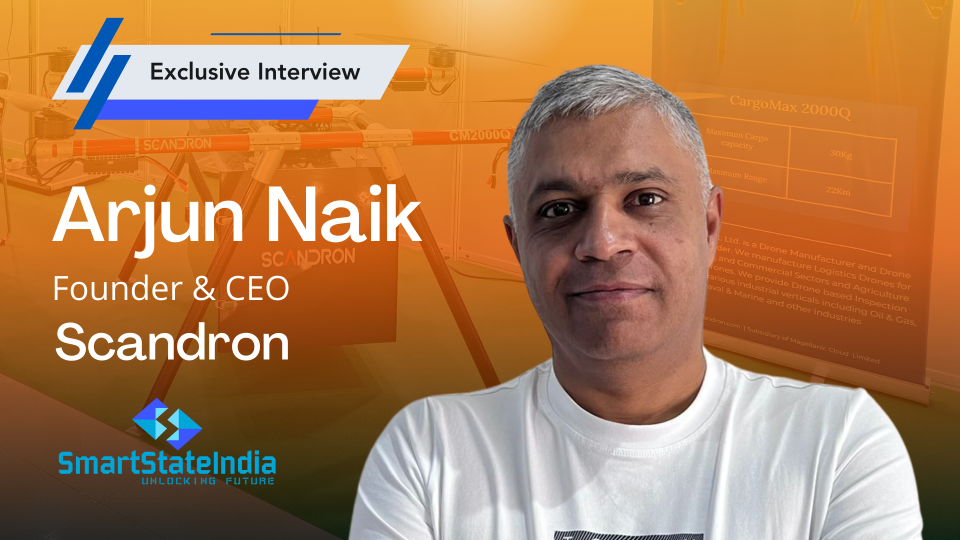Today, Scandron stands as a pivotal player in the thriving drone industry, offering hub-to-hub logistics solutions across various sectors and specializing in high-altitude logistics drones for defense applications. Their prominent role as the preferred partner for drone-based inspections in the Oil and Gas industry emphasizes their expertise and commitment to innovation. Scandron’s forward-thinking approach in energy sectors and their groundbreaking technology for confined space investigation truly highlights their dedication to pioneering solutions. In this exclusive interview, Arjun Naik, Founder and CEO of Scandron Pvt. Ltd., sheds light on the company’s intricate journey, the challenges faced within India’s regulatory landscape, and Scandron’s crucial contributions to furthering the ‘Make in India’ initiatives.
Could you share an overview of Scandron’s journey and how the company has evolved in pioneering drone technology for different industries? What specific applications have you found particularly impactful or innovative?
The core Team at Scandron has more than 100 Man Years of experience designing, developing and manufacturing drones. Scandron has developed disruptive drone technologies that allow us to help various industries to more efficiently perform certain tasks. We started by providing Drone based inspection Services to the Oil and Gas Industry and other industry verticals, Parallely we started designing and developing our Logistics Drones to address a requirement in both the Industrial and Defence Sectors. Today we are the go to option for Drone Hub to hub Logistics commercially and High Altitude Logistics Drones for the Armed Forces. We are also the partner of choice for the Oil and Gas Industry for Drone based Inspections.
Navigating the drone industry involves technological advancements and compliance with regulations. What notable technological or regulatory hurdles have you encountered as a drone manufacturer and operator in India, and how have you addressed these challenges?
Drone Technology is advancing very rapidly, and the regulatory landscape is evolving along with this nascent Industry. The Government and regulatory bodies are doing a pretty good job by providing a well-defined framework for the industry to grow and mature. Challenges remain in terms of testing requirements and facilities, import export requirements, training facilities and trained manpower, but all in all things are moving in the correct direction.
In the context of fostering “Make in India” initiatives, what key elements within the ecosystem—be it talent, regulatory support, or local component manufacturing—are crucial for the drone industry’s self-sufficiency and reduced reliance on imports? How does Scandron actively contribute to this vision?
In the context of “Make in India”, the major components that are being imported are Motors, Batteries and Communication Systems. To achieve self-sufficiency with these components, the government needs to support the industry to help them offset the costs of the Extensive Capital Investments, The costs for R&D and Testing that is required to bring these components up to industry standards of reliability and performance. Scandron is working towards this by partnering with International Manufacturers to manufacture thee components locally under a TOT to start with and then mobbing onto fully indigenised components. We also make our drones available for component testing to various companies that are developing these components indigenously.
Could you elaborate on the spectrum of services offered under Drone-as-a-Service by Scandron? How do these solutions specifically address the diverse needs of your clients across industries?
Our Drone-as-a-Services Vertical includes External Visual and Thermal Inspection, Confined Space Inspections (Internal Inspections) and Drone Flying Services. We provide these services to the following Industrial Verticals: Oil & Gas, Steel Mills, Mines, Marine Vessels, FPSOs and Defence PSUs. Our premium offering is the Drone Confined Space Inspections, wherein our drones inspect Assets internally, without the need for scaffolding, lighting or for people to work at heights.
Considering the landscape in India, which sectors or domains do you believe are most conducive to drone applications? Within this context, what specific areas are you prioritizing, and what unique advantages do your solutions offer in these domains?
For our Drone Services, we believe the Energy Sector is where the future is and we are focused on developing and providing Drone Inspection Services to various Energy verticals especially Oil and Gas. As far as manufacturing goes, we are focused on manufacturing logistics drones for defence requirements and for hub to hub operations commercially. We have disruptive technology that makes our logistics drones unique in terms of how they can be safely and repetitively operated for commercial success.
In the realm of confined space investigation, what types of drones do you find most suitable, and why? How do these drones effectively inspect and navigate challenging spaces like pipes or ventilation systems?
We offer confined space inspection using unique drones equipped with GPS free stabilization, Onboard lighting, collision tolerance, HD close View cameras. These drones are combined with an image exploitation Software that allows us to map the asset being inspected and measure anomalies that are observed. This allows us to help the customer visualize the exact location of anomalies and to gain measurable insights. We have a flight planning system that allows us to conduct confines space inspection of almost any asset including pipes and ventilation systems safely and cost effectively.
Looking forward, what emerging trends or developments do you foresee in the utilization of drones for confined space investigation? How do you envision these advancements influencing safety protocols or emergency response strategies, particularly in scenarios like search and rescue missions?
In the near future confined space inspection drones will become more powerful tools by deploying multiple inspection and mapping sensors simultaneously. Drone Autonomy will also play a larger role in allowing these drones to navigate independently of external pilot control. As these drones become smaller and more autonomous, they will become first response tools for search and rescue missions. They would be ideal to navigate treacherous areas independently and locate survivors. They would also be able to help develop rescue strategies by creating visual models of affected areas.



